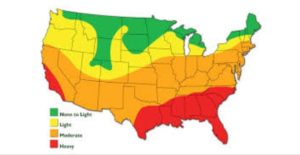Termite Prevention & Control
Like any other structures containing wood components, log homes are subject to attack by a variety of wood destroying insects including termites. The threat from insects is no greater for log construction than conventional wood frame construction. While the prevention and control of termites is typically assigned to a professional pest control company (such as termite control los angeles), combining appropriate design and construction measures with maintenance inspections can help eliminate conditions conducive to termite attack.
One sign of a termite infestation is a termite swarm within the home. Many people mistakenly identify swarming termites as flying ants… Ants have a narrow waist whereas the termite’s body is straight back to the abdomen. When termites swarm in the thousands, a common first impulse is to run for the can of pesticide and spray them down, but there is no reason to do this since all the swarming termites will be dead in an hour or so anyway. Instead, vacuum them up and then call a pest control professional for a termite inspection, as this swarm is a sure indication that a mature termite colony is located within or close to the structure. Termites need to maintain a moist environment and are attracted to cellulose and water; thus, wet wood provides an ideal environment for them. Once a home is infested, the most common method of treatment is a structural fumigation. Heat treatments and localized electrical elimination methods have been used successfully, but, like fumigation, do not leave residual protection against future infestations. Chemicals also have been used to both eliminate existing infestations and protect the wood from future infestations.
Effective, integrated termite prevention relies on quality design, construction, and maintenance as for long term protection.
Design Specifications
1. Use chemically treated or durable wood products.
2. Use solid piers or stem walls (hollow ones are a common entry point for termites).
3. Install termite shields.
4. Waterproof Basements and provide a drain.
5. Ventilate Crawl Space.
6. Keep all wood at least 18” from the surface of any soil by raising the foundation. Do not allow ground contact of any floor or wall materials.
7. Use proper techniques to move roof and deck water runoff well away from the foundation.
During Construction
1. Maintain the 18” soil-wood separation during backfill and landscaping.
2. Grade the site to keep the soil around the foundation dry.
3. Either burn or remove all wood steaks, tree stumps, or other scrap wood from the site.
Ongoing Care
1. Keep wood-based ground cover (including mulch, straw, leaves, etc.) at least 24” from the foundation.
2. Keep water sprinklers faced away from the house.
3. Make sure proper drainage is applied to the AC unit.
4. Proper home maintenance, including keeping gutters and downspouts free of debris, keeping your home free of mold and fungi.
Employ a Good Inspection Routine
1. Complete frequent visual inspections for signs of termites, mud tubes going up walls or vertical surfaces, bulging paint, discolored wood, or wood damage.
2. Inspect crawl space for any water leaks as well as inspecting crawl space vents for any blockage.
3. Most dry wood termite colonies become established through exposed wood ends accessible from cracks and crevices. Signs of an infestation include finding small hard fecal pellets on the floor or other surfaces and seeing winged termites, especially on windowsills.
4. Maintain a regularly scheduled inspection routine with a professional. https://www.888logguys.com/log-home-maintenance
Please see the TIP (Termite Infestation Probability) Map, developed by the US Forest Service, to see where you fall!









